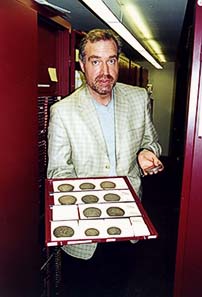by Ursula Kampmann
After lengthy disputes it is finally decided. The Collection of the House of Welf remains in Hanover. The state of Lower Saxony purchases the unique cabinet for 5 million Euros – that really is a bargain considering the number of treasures the cabinet contains.
December 31, 2009 – On December 14th, 2009, the Hannoversche Allgemeine Zeitung gave the all-clear signal: the dissolution of one of the last big princely collections in private hands is not under consideration anymore. The Deutsche Bank and the State of Lower Saxony had reached an agreement. The collection of the House of Welf changed hands for five million Euros.
40.000 coins and medals are contained in this collection that was built up by the rulers of the Welf dynasty since the middle of the 18th century. Thanks to the fact that the Electors of Brunswick-Lüneburg were kings of Great Britain and Ireland in personal union in those days, not only German rarities can be found in that collection but also English coins as well as rarities from the British Empire. As early as 1983 the collection was in danger of being dislocated abroad. The House of Welf was thinking of selling its collection with the aid of a British auction house. The Deutsche Bank prevented that by acquiring the collection and its 40.000 objects for 16.2 million DM.
Since then, the large collection was stored in the Deutsche Bank headquarters in Hanover with parts of it exhibited in a separate room. The collection was curated by Rainer Cunz who will continue his work in the future: now the collection moves to the Lower Saxony State Museum where Rainer Cunz works as numismatist.
Reiner Cunz presenting coins from the Welfs Collection.
It is only natural that the politicians aim to make the treasures, which after all were acquired from public funds, available to a broad audience as soon as possible. Minister of Culture, Lutz Stratmann, therefore announced: “We are optimistic that a first exhibition of the coin cabinet can be presented as early as next year.” Of course, a number of spectacular pieces will be exhibited in 2014, in the context of the huge State Exhibition on the occasion of the 300th anniversary of the Personal Union of Hanover with Great Britain.
This agreement in the interest of Numismatics was first and foremost achieved when the individual organizations and associations protested in strongest terms. The German Numismatic Society had submitted their petition, signed by 3.000 people at home and abroad, at the right time. The continuance of the collection in Hanover proves the point that coin collectors should join forces. Only then the interest of Numismatics can be successfully represented on a major level.
More information at http://beta.haz.de/Nachrichten/Feuilleton/Uebersicht/Niedersachsen-zahlt-fuer-Muenzkabinett-fuenf-Millionen-Euro





